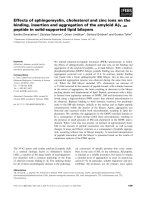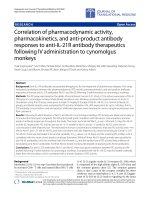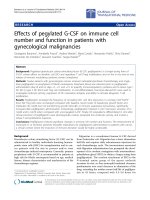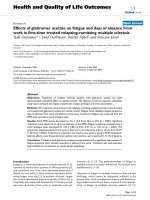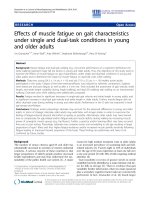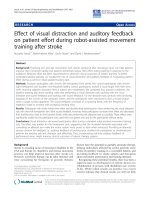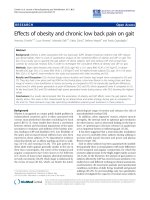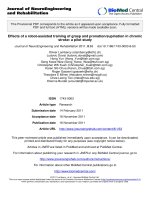Báo cáo hóa học: " Effects of paraoxonase activity and gene polymorphism on coronary vasomotion" pot
Bạn đang xem bản rút gọn của tài liệu. Xem và tải ngay bản đầy đủ của tài liệu tại đây (252.34 KB, 7 trang )
ORIGINAL RESEARCH Open Access
Effects of paraoxonase activity and gene
polymorphism on coronary vasomotion
Vincent Dunet
1
, Juan Ruiz
2
, Gilles Allenbach
1
, Paola Izzo
2
, Richard W James
3
and John O Prior
1*
Abstract
Background: Paraoxonase 1 [PON1] is recognized as a protective enzyme against LDL oxidation, and PON1
polymorphism has been described as a factor influencing coronary heart disease [CHD] free survival. As coronary
vasoreactivity is a surrogate of future cardiovascular events, we aimed at assessing the respective effe ct of the
PON1 genotype and activity on coronary vasoreactivity in a population of type 2 diabetic patients.
Methods: Nineteen patients with type 2 diabetes mellitus underwent
82
Rb cardiac PET/CT to quantify myocardial
blood flow [MBF ] at rest, during cold pressor testing [CPT], and during adenosine-induced hyperaemia to compute
myocardial flow reserve [MFR]. They were allocated according to Q192R and L55M polymorphisms into three
groups (wild-type and LM/QR heterozygotes, MM homozygotes, and RR homozygo tes) and underwent a
measurement of plasmatic PON1 activity. Relations between rest-MBF, stress-MBF, MFR, and MBF response to CPT
and PON1 genotypes and PON1 activity were assessed using Spearman’s correlation and multivariate linear
regression analysis.
Results: Although PON1 activity was significantly associated with PON1 polymorphism (p < 0.0001), there was no
significant relation between the PON1 genotypes and the rest-MBF, stress-MBF, or MBF response to CPT (p ≥ 0.33).
The PON1 activity significantly correlated with the HDL plasma level (r = 0.63, p = 0.005), age (r = -0.52, p =
0.027), and MFR (r = 0.48, p = 0.044). Moreover, on multivariate analysis, PON1 activity was independently
associated with MFR (p = 0.037).
Conclusion: Our study supports an independent association between PON1 activity and MFR. Whether PON1
contributes to promote coronary vasoreactivity through its antioxidant activity remains to be elucidated. This
putative mechanism could be the basis of the increased risk of CHD in patients with low PON1 activity.
Keywords: paraoxonase, myocardial flow reserve, diabetes, rubidium-82
Background
Coronary heart disease [CHD] is the first cause of mor-
tality in type 2 diabetic patients. Several risk factors
have been recognized to contribu te to the development
of atherosclerotic lesions resulting in a decrease o f cor-
onary blood flow and myocardial ischemia. Among
those factors, low high-density lipoprotein [HDL]
plas ma levels have emerged as one of the strongest pre-
dictor of CHD [1]. As a consequence, the mechanism by
which HDL influences atherosclerosis has been exten-
sively studied, and HDL has been shown to reduce
oxidative stress and plaque formation. These antioxidant
properties of HDL have been attributed to enzymes
associated to HDL.
Paraoxonase 1 [PON1] is an enzyme exclusively
located on HDL in serum [2]. PON1 hydrolyzes organo-
phosphate substrates and metabolizes lipid peroxides
leading to protect against accumulation of low-density
lipoprotein [LDL] that contributes to atherosclerotic pla-
que formation. PON1 activity is in part determined by
genetic polymorphism. Glutamine-192-arginine [Q192R]
is a strong determinant of PON1 activity against exo-
genous substrates and has been associated with an inde-
pendent cardiovascular risk [3,4]. Recent studies suggest
that PON1 activity is m ore important than genotype to
predict CHD [5,6]. However, the exact influence o f
* Correspondence:
1
Department of Nuclear Medicine, Centre Hospitalier Universitaire Vaudois
(CHUV) and University of Lausanne, Rue du Bugnon 46, Lausanne, 1011,
Switzerland
Full list of author information is available at the end of the article
Dunet et al. EJNMMI Research 2011, 1:27
/>© 2011 Dunet et al; licensee Springer. This is an Open Access article distributed under the terms of the Creative Commons Attribution
License (ht tp://creativecommons.org/licenses/by/2. 0), which permits unrestrict ed use, distrib ution, and reproduction in any medium,
provided the original work is properly cited.
PON1 genotype and activity on coronary blood flow
remains uncertain. Malin et al. [7] showed that the
PON1 genotype was neither sig nificantly correlated with
coronary blood flow respo nse to adenosine stress nor
with coronary flow reserve, both being recognized as
surrogate markers of CHD. Interestingly, Yildiz et al. [8]
foundthatindirectassessmentofcoronarybloodflow
on coronary angiography was associated with PON1
activity in a patient with a ‘slow coronary flow ’ entity.
Nevertheless, there is no evidence of a direct relation
between PON1 activity and absolute coronary blood
flow in type 2 diabetic patients.
Thus, we aimed at assessing the relation of PON1
genotype and activity to myocardial blood flow and
myocardial flow reserve in a popula tion of type 2 dia-
betic patients using
82
Rb cardiac posit ron emission
tomography/computed tomography [PET/CT].
Methods
Study design
In this monocentric study, patients with type 2 diabetes
mellitus and PON1 polymorphism followed in the
Department of Endocrinology, Diabetology and Metabo-
lismoftheUniversityHospitalofLausannewerepro-
spectively enrolled from January to June 2009. Before
inclusion, they all underwent a medical examination to
screen for other cardiovascular risk factors: past or pre-
sent smoking, hypertension (≥140/90 mmHg), LDL,
HDL, and triglyceride [TG] levels, and family history of
early CHD. Moreover, all patients with peripheral artery
disease, known coronary artery disease or myocardial
infarction, cardiomyopathy, renal failu re, peripheral neu-
ropathy, systemic disease or contraindication to adeno-
sine (asthma, chronic obstructive bronchitis, second and
third atrioventricular blocks) were excluded.
For every patient included, fa sting glucose plasma,
insulin plasma, LDL, HDL, TG, and high sensitivity C-
reactive protein [hsCRP] levels were measure d, and
insulin resistance was assessed by calculating the home-
ostasis model assessment [HOMA-IR] in dex (HOMA-IR
= fasting plasma glucose (mmol/L) × fasting plasma
insulin (μU/mL)/22.5). The hsCRP/paraoxonase ratio
was also computed. Patients refrained from any food for
at least 6 h and from caffeine intake for ≥24 h before
the PET studies. Every patient signed a written informed
consent , and the study was approved by the ethics com-
mittee of the University of Lausanne.
Paraoxonase 1 genotype and activity determination
PON1 polymorphisms in positions 192 (glutamine ® arg i-
nine) a nd 55 (leucine ® methionine) were genotyped by
different methods. PON1 Q192R polymorphism was
detected by polymerase chain reaction [PCR] amplification
of specific alleles, and PON1 L55M polymorphism, by the
restriction fragment l ength polymorphism method using
the Hsp92II enzyme. Lymphocytes were isolated from the
blood, and DNA was extracted using standard procedures.
For PON1 Q192R genotyping, PCRs were performed on
Robocycler
®
Gradient 96 (Stratagene
®
, La Jolla, CA, USA)
using primers described by Pinizzotto et al. [9]. It involved
an initial denaturation at 95°C carried out for 5 min, fol-
lowed by 35 cycles including denaturation at 95°C for 45 s,
annealing at 58°C for 45 s, and elongation at 72°C for 1
min. The pro cedure was completed by a final incu bation
at 72°C for 7 min. For PON1 L55M genotypi ng, P CRs
were carried out under the same conditions but for 28
cycles only. Fragments obtained were 500 bp long for the
PON1-192 polymorphism, 384 bp long for the PON1-55
wild type, and 282 and 102 bp long for the PON1-55
mutant. All fragments were finally separated on a 2% agar-
ose gel electrophoresis and visualized by ethidium
bromide.
Serum PON1 activity was measured with paraoxon as
substrate. Practically, the PON1 activity was measured by
adding 20 μL of serum to a Tri s buffer (1 00 mmol/L, pH
8.0) containing 2 mmol/L CaCl
2
and 5. 5 mmol/L para-
oxon ( O,O-diethyl-O-p-nitrophenylphosphate; Sigma-
Aldric h Co., St. Louis, MO, USA). The rate of generation
of p -nitrophenol was determined over 3 min at 405 nm
and 25°C, as previously described by James et al. [10].
82
Rb cardiac PET/CT assessment
All patients underwent a series of three
82
Rb cardiac
PET/CT (Discovery LS, GE Healthcare, Milwaukee, WI,
USA) studies. After a rest study, a cold pressor test
[CPT] was carried out t o assess myocardial blood flow
[MBF] variations mainly due to endothel ium-dependent
vasomotion.CPTwasdonebya2-minimmersionof
the left lower limb on ice water starting 1 mi n before
the administration of
82
Rb. Ten minutes afterwards, a
pharmacological hyperemic stress was performed by
aden osine infusion (140 μg/kg/mi n) over 6 min to mea-
sure a myocardial blood flow increase ( stress-MBF)
mainly due to endothelium-independent va somotion
and myocardial flow reserve (MFR = stress-MBF/rest-
MBF), which also helped to exclude any underlying cor-
onary artery disease. For each study, after a 10-s infu-
sion of
82
Rb (1450 MBq), a 6-min dynamic cardiac PET
was acquired. Cardiac CT scans were also performed to
correct for photon attenuation by s oft tissues (before
the rest study and just after the stress study). The good
alignments between the PET and CT series were
checked to avoid attenuation correction mistakes.
Data were processed with the full-automatic Flow-
Quant 1.2.3 software using a previously described one-
tissue compartment modeling approach [11] to estimate
the MBF at rest, during the cold pressure test, and dur-
ing the pharmacological stress. Blood pressure, heart
Dunet et al. EJNMMI Research 2011, 1:27
/>Page 2 of 7
rate, and a 12-lead ECG were recorded at 1-min inter-
vals during each procedure. To correct for cardiac work-
load, rest an d CPT myocardial blood flows we re
normalized using the rate-pressure product (RPP =
heart rate × systolic blood pressure).
Statistical analysis
All statistical analyses carried out with Stata 10.1 contin-
uous variables are presented as mean ± SD or as median
(interquartile range, IQR). Allele frequencies were esti-
mated by the gene-counting method, and Hardy-Wein-
berg’ s equilibrium was tested by chi-square test. To
obtain a more meaningful genotype group size, patient s
were pooled into three groups: (1) wild-type, LM, and
QR heterozygotes (group 1, n = 7); (2) MM homozy-
gotes ( group 2, n = 5); and (3) RR homozygotes (group
3, n = 6). Variable differences between these three geno-
type subgroups were assessed using one-way analysis of
variance. Relations betwee n variables were assessed
using non-parametric Spearman’ s rank correlation (r).
We secondly performed multivariate regression analysis
( b) and stepwise multiple linear regression analysis to
determine independent relationships to the PON1 activ-
ity or MBF, including all variables with significant corre-
lations on univariate analysis. A p value < 0.05 was
considered as statistically significant.
Results
Study population
In total, 19 patients (11 men, 8 women) with type 2 dia-
betes mellitus were enrolled. The clinical char acteristics
are summarized in Table 1. Among these patients, t en
(53%) were wild-type, two (10%) were heterozygous, and
seven (37%) were homozygous for Q192R polymorph-
ism. Moreover, 11 (58%) were wild-type, 3 (16%) were
heterozygous, and 5 (26%) were homozygous for L54M
polymorphism. Both genotype distributions did not fol-
low Hardy-Weinberg’s equilibrium (c
2
= 11.6 and 8.0,
respectively; p < 0.01). All patients underwent the three
PET/CT studies, and none had unexpected side effects
during adenosine infusion. None had decreased stress-
MBF < 2 mL/min/g or MFR < 2, thus excluding any
hem odyn amically significant coronary artery disease; no
locally decreased myocardial perfusion imaging at rest
was seen, exclud ing myocardial infarct. For one pati ent,
PON1 activity measurement could not be subsequently
measured on the blood sample. Laboratory, MBF, and
MFR results of this patient were thus not included in
subgroup comparisons.
Relation to PON1 genotype
PON1 activity and laboratory results according to geno-
type subgroups are displayed in Table 2. Group 3 had a
higher PON1 activity (168 ± 28 U/L) when compared
with groups 1 (51 ± 35, p < 0.0001) and 2 (11.9 ± 6.7, p
< 0.0001; Figure 1a), and there was a trend for a differ-
ence between g roups 1 and 2 (p = 0.083). Arylesterase
activity was not statistically different according to the
PON1 genotype (p = 0.22). None of the common biolo-
gical variables were significantly influenced by the
PON1 genotype. Moreover, we did not find any signifi-
cant difference for rest-MBF, CPT-MBF, MBF difference
between CPT and rest, stress-MBF or MFR between
groups 1, 2, and 3 (Table 3, Figure 1b,c,d,e).
Relation to PON1 activity
PON1 and arylesterase activities were both strongly
associated with HDL plasma level (r =0.63,p =0.005
and r = 0.71, p = 0.001, respectively). PON1 activity was
also correlated with age (r = - 0.52, p = 0.027) and with
arylesterase activity (r =0.61,p = 0.008). Moreov er,
there was a trend for a negative correlation between
hsCRP and PON1 activity ( r = -0.36, p =0.14).Includ-
ing significant univariate predictors (age, HDL, arylester-
ase activity, and MFR), the multivariate linear regression
analysis revealed that HDL (p = 0.04) was independently
related to the PON1 activity (Table 4). Likewise, using
thesameunivariatepredictors, stepwise multiple linear
regression analysis highlighted that both HDL (p =
0.015) and MFR (p = 0.037) we re independently asso-
ciated with the PON1 activity.
Table 1 Study population characteristics
Variable (n = 19) Mean ± SD or median (IQR) or
n (%)
Age (years) 57.6 ± 9.8
Sex (% of women) 8 Women/11 men (42% women)
Weight (kg) 77 (66-94)
Body mass index (kg/m
2
) 25.9 (22.1-30.9)
Current smoking 3 (16%)
Hypertension 15 (80%)
Dyslipidemia 12 (63%)
Family history of early CHD 0 (0%)
Overall cholesterol (mmol/L) 4.2 ± 0.8
LDL-cholesterol (mmol/L) 2.3 ± 0.7
HDL-cholesterol (mmol/L) 1.2 ± 0.3
Triglyceride levels (mmol/L) 1.2 (0.9-1.8)
Fastening insulin (μU/mL) 10.8 (6.9-21.6)
Fastening glucose (mmol/L) 5.8 (5.4-7.5)
HOMA-IR (1) 3.3 (1.8-5.0)
hsCRP (mg/L, normal < 5 mg/L) 1.1 (0.4-2.8)
PON1 (U/L; n = 18) 79.3 ± 71.7
Arylesterase (U/L; n = 18) 41.0 (38.9-48.3)
Ratio hsCRP/PON1 × 1,000 (mg/U; n
= 18)
47.1 (7.3-312)
IQR, interquartile range; CHD, coronary heart disease; LDL, low-density
lipoprotein; HDL, high-density lipoprotein; HOMA-IR, homeostasis model
assessment-insulin resistance; hsCRP, high sensitivity C-reactive protein.
Dunet et al. EJNMMI Research 2011, 1:27
/>Page 3 of 7
0
50
100
150
200
WT+
HETEROZYGOTES
HOMOZYGOTES
−MM
HOMOZYGOTES
−RR
Paraoxonase activity (U/L)
−.5
0
.5
1
WT+
HETEROZYGOTES
HOMOZYGOTES
−MM
HOMOZYGOTES
−RR
∆MBF CTP (mL/min/g)
0
1
2
3
4
5
WT+
HETEROZYGOTES
HOMOZYGOTES
−MM
HOMOZYGOTES
−RR
Stress MBF (mL/min/g)
0
1
2
3
4
5
WT+
HETEROZYGOTES
HOMOZYGOTES
−MM
HOMOZYGOTES
−RR
Rest MBF (mL/min/g)
0
1
2
3
4
5
WT+
HETEROZYGOTES
HOMOZYGOTES
−MM
HOMOZYGOTES
−RR
MFR (1)
a
p<0.0001
p=0.35
p=0.33
p=0.56
p=0.48
*
†
b
c de
Figure 1 Effect of paraoxonase genotype on paraoxonase activity and myocardial blood flow parameters. Effect of paraoxonase
genotype on (a) paraoxonase activity, (b) response to cold pressor testing (ΔMBF, increase in myocardial blood flow), (c) rest MBF, (d) stress
MBF, and (e) MFR. Note that the paraoxonase genotype only had an effect on paraoxonase plasma levels (p < 0.0001), while there was no
association with PET-measured indices of endothelium-dependent (ΔMBF) or -independent (stress MBF, MFR) vasomotion. Asterisks represent p <
0.0001 vs. wild type [WT] + heterozygotes and p < 0.0001 vs. homozygote-MM; dagger represents p = 0.083 vs. homozygotes-MM.
Table 2 Laboratory analyses according to paraoxonase genotype subgroups
Variable (n = 18) Group 1
a
(n =7)
Group 2
b
(n =5)
Group 3
c
(n =6)
p value*
LDL-cholesterol (mmol/L) 2.3 ± 0.9 2.5 ± 0.6 2.1 ± 0.3 0.71
HDL-cholesterol (mmol/L) 1.1 ± 0.3 1.0 ± 0.1 1.3 ± 0.3 0.16
Triglyceride levels (mmol/L) 2.1 ± 0.7 1.7 ± 0.8 2.1 ± 2.5 0.90
Fastening insulin (μU/mL) 26.2 ± 15.0 23.2 ± 17.9 40.3 ± 55.0 0.67
Fastening glucose (mmol/L) 8.3 ± 3.7 8.7 ± 2.5 7.7 ± 2.9 0.86
HOMA-IR (1) 11.0 ± 10.9 8.8 ± 6.8 18.6 ± 32.8 0.70
hsCRP (mg/L, normal < 5 mg/L) 5.6 ± 7.1 5.6 ± 5.7 1.6 ± 1.9 0.36
PON1 activity (U/L) 51.1 ± 35.3 11.9 ± 6.7 168 ± 27 <0.0001
Arylesterase (U/L) 46.5 ± 14.0 36.2 ± 8.9 45.9 ± 5.5 0.22
Ratio hsCRP/PON1 × 1,000 (mg/U) 365 ± 774 401 ± 254 10.0 ± 12.5 0.37
*p Values were calculated using one-way analysis of variance.
a
Group1 = wild type + LM/QR heterozygotes;
b
group 2 = MM homozygotes;
c
group 3 = RR
homozygotes; PON1, paraoxonase 1; LDL, low-density lipoprotein; HDL, high-density lipoprotein; HOMA-IR, homeostasis model assessment- insulin resistance;
hsCRP, high sensitivity C-reactive protein; MM, methionine-methionine; RR, arginine-arginine.
Dunet et al. EJNMMI Research 2011, 1:27
/>Page 4 of 7
Regarding myocardial flow quantitation, we found no
significant correlation between myocardial blood flow at
rest, at stress, or myocardial blood flow response to
CPT and patients’ characteristics depicted in Ta ble 1.
However, on univariate analysis, myocardial flow reserve
was correlated with PON1 activity only (r = 0.48, p =
0.044, Figure 2).
Discussion
Since CHD is the first cause of mortality in type 2 dia-
betic patients, cardiovascular risk factors have been
extensively studied to improve the understanding of
atherosclerosis and mechanisms leading to the
development of coronary artery disease. Whereas PON1
genotypes and activities have been described as indepen-
dent predictors of CHD [5,6], there was no evidence of a
reduction of hyperemic MBF. Thus, our study is the first
report of an independent relation between PON1 activ-
ity and MFR assessed by cardiac PET/CT.
Owing to the need of a better understandin g of ather-
osclerosis development and protective factors, the role
of HDL has been extensively studied and i s known as
one of the strongest protectors against coronary artery
disease [1]. Consequently, the influence of PON1 poly-
morphism as a main component of the HDL complex
was assessed. Among several polymorphisms, Q192R
and L55M emerged as the most interesting [3]. PON1
192R and PON1 55L were reported as more efficient in
decreasing hydrolysis of lipid peroxides by promoting
PON1 activity [4]. Our data confirm that PON1 activity
is significantly different according to PON1 genotypes
Table 4 Univariate (r) and multivariate (b) correlations
between PON1 activity and study population
characteristics
Variable (n = 18) Univariate Multivariate
r p value b p value
Age -0.52 0.03 -0.28 0.3
Sex 0.08 0.8
Weight -0.33 0.18
Body mass index -0.43 0.07
Overall cholesterol 0.08 0.7
LDL-cholesterol 0.01 1.0
HDL-cholesterol 0.63 0.005 0.52 0.04
Triglyceride -0.24 0.33
Insulin 0.11 0.65
Glucose -0.17 0.5
HOMA-IR 0.03 0.9
hsCRP -0.36 0.14
Arylesterase 0.61 0.008 -0.05 0.8
Rest-MBF 0.03 0.9
Stress-MBF 0.15 0.5
MFR 0.48 0.04 0.34 0.2
CPT-MBF -0.18 0.47
MBF difference CPT-rest -0.17 0.5
Relations between variables were assessed using non-parametric Spearman’s
correlation coefficients (r). Independent relations were assessed using
multivariate regression analysis (b). PON1, paraoxonase 1; LDL, low-density
lipoprotein; HDL, high-density lipoprotein; HOMA-IR, homeostasis model
assessment- insulin resistance; hsCRP, high sensitivity C-reactive protein; MBF,
myocardial blood flow; MFR, myocardial flow reserve; CPT, cold pressor test.
2
3
4
5
MFR (1)
0 50 100 150 200
Paraoxonase activity (U/L)
ρ = 0.48
p = 0.044
Figure 2 Paraoxonase activity effect on MFR showing an
association between increased paraoxonase level and better
MFR. The gray shading represents the 95% confidence area.
Table 3 Myocardial blood flow values according to paraoxonase genotype subgroups
Variable (n = 18) Group 1
a
(n =7)
Group 2
b
(n =5)
Group 3
c
(n =6)
p value*
Rest-MBF (mL/min/g) 1.2 ± 0.4 1.1 ± 0.3 1.0 ± 0.5 0.56
CPT-MBF (mL/min/g) 1.4 ± 0.5 1.5 ± 0.5 1.2 ± 0.3 0.48
MBF difference CPT-rest (mL/min/g) 0.2 ± 0.3 0.4 ± 0.3 0.2 ± 0.5 0.55
MBF difference CPT-rest (%) 18 ± 17 36 ± 16 40 ± 51 0.46
Stress-MBF (mL/min/g) 3.0 ± 0.8 2.5 ± 0.6 2.5 ± 0.6 0.33
MFR (1) 2.7 ± 0.7 2.4 ± 0.3 3.1 ± 1.1 0.35
*p Values were calculated using one-way analysis of variance.
a
Group1 = wild type + LM/QR heterozygotes;
b
group 2 = MM homozygotes;
c
group 3 = RR
homozygotes. CPT, cold pressor test; MBF, myocardial blood flow; MFR, myocardial flow reserve; MM, methionine-methionine; RR, arginine-arginine.
Dunet et al. EJNMMI Research 2011, 1:27
/>Page 5 of 7
( p < 0.0001). The PON1 activity of the MM genotype
was low (11.9 ± 6.7 U/L), but this may be due to the
small number of subjects (n = 5) and to the fact that
MM patients in our study are all QQ homozygotes,
which is an additional genetic factor that low ers paraox-
onase activity.
Studies aiming at assessing the predictive value of
PON1 polymorphism found controversial results.
Whereas a few studies reported that PON1 R allele was
independently related to CHD, others failed to show it
[12]. A recent study by Acampa et al. found no differ-
ence in genotype between CAD-suspected patients with
and without ischemia undergoing cardiac SPECT [13].
This highlights the limits of the genotyping approach
that conceals exte rnal influence upon enzyme function.
For instance, in our study, age was correlated with
PON1 activity (r =-0.52,p = 0.027) that sustains the
hypothesis of an age-dependent decrease of PON1 activ-
ity [14], which may be due to the development of oxida-
tive stress conditions with aging such as systemic
inflammation, leading to an increased risk of CHD.
MBF and MFR both have predictive values of cardio-
vascular event-free survival [15,16]. According to geno-
type, we found no difference of MBF at rest, during the
CPT, or at stress. Pasqualini et al. reported a correlation
between PON1 activity and peripheral endothelium-
dependent vasoreactivity in patients with peripheral
artery disease [17]. Although they performed a flow-
mediated dilation measurement with good intra-obser-
ver reproducibility, this technique presents a high varia-
bility [18] that may be a concern in reproducing such
results. Using similar highly reproducible PET/CT meth-
ods [19] such as that used in our study, Malin et al.
found no d ifferenc e of h yperemi c MBF b etween geno-
type groups in a populat ion of 49 young healthy men
[7]. Our study extends their results in a patient popula-
tion with type 2 diabetes, but not with other associated
health conditions where we did not find any difference
in response to adenosine or CPT according to genotype.
Nor was there any correlation between PON1 activity
and CPT-MBF, suggesting that PON1 is not involved in
atherosclerosis by an impairment of endothelium-depen-
dent coronary vasoreactivity. Regarding PON1 activity
rather than PON1 genotype, we found an independent
correlation between PON1 activity and MFR (p =
0.037). In several studies, PON1 192R was described as
an independent cardiovascular risk factor [12]. Mackness
et al. [5] highlighted in a 417-patient population com-
pared with 282 control subjects that not PON1 Q192R
polymorphism, but PON1 activity was significantly
lower in patients experiencing CHD. Moreover, Bhatta-
charyya et al. [20] brought to light that PON1 activity
independently predicted major adverse cardiac event-
free survival. T hough we report a positive association
between PON1 activity and MFR, the exact influence of
PON1 on mainly endothelium-independent coronary
vasoreactivity remains unclear. Whether PON1 may
concur in modifying MFR needs to be investigated
further. It could constitute a putative mechanistic link
to clarify the predictive value of PON1 activity on CHD
occurrence. This association ma y be of importance in
type 2 diabetic patients who have decreased levels of
HDL cholesterol.
Although we report for the first time a direct relation
between MFR and PON1 a ctivity, our study presents
some limitations. We decided to focus on patients with
type 2 diabetes mellitus whose geno type was already
known. Our study was carried out in a selected, small
population of patients with type 2 diabetes mellitus,
hence resulting in de viations from Hardy-Weinberg’ s
equilibrium. Regardless, our results need to be confirmed
in a larger prospective cohort of patients with type 2 dia-
betes mellitus. The absence of correlation between the
MBF response to adenosine o r CPT regarding the PON1
genotype or PON1 activity confirms the results of Malin
et al.[7] and would be in a greement with the study of
Acampa et al. [13]. This seems to indicate that PON1 is
not involved i n the development of atherosclero sis by an
impairment of endothelium-dependent vasomotion, but
the exact mechanism r emains unknown. Furthermore,
PON1 activity variations may be a part of a multifactorial
mechanism leading to a decreased coronary vasoreactiv-
ity. The relative effect of PON1 on coronary vasomotion
as well as its relative value in predicting cardiac event-
free survival remains to be determined.
Lastly, a power analysis indicates that the proposed
patient allocation into three groups of paraoxonase gen-
otype would have allowed the showing of ≥50% differ-
ences in MBF or MFR according to genotype (type I
error a = 0.1, power 1-b = 0.8), which were n ot
observed. However, smaller differences might have been
missed by the present study due to the small po pulation
size.Thus,smallergenotype-related effects cannot be
excluded by our study, and larger multicenter studies
would be needed to exclude such an effect.
As cardiac PET/CT has the ability to detect early MFR
mod ification under therapy, this may help in investigat-
ing new PON1 activity-enhancing combinations of nico-
tinic acid a nd laropiprant, such as those currently used
in the HPS2-THRIVE [21].
Conclusion
Our study demonstrates an association b etween PON1
activity and MFR in type 2 diabetic patients though the
exact mechanism by which PON1 influences MFR
remains unclear. Our study also shows no evidence of
PON1 influencing endothelium-dependent vasoreactiv-
ity. The mechanism linking PON1 activity and MFR
Dunet et al. EJNMMI Research 2011, 1:27
/>Page 6 of 7
remains to be determined though. This might open new
perspectives for treatments aiming to improve MFR by
promoting PON1 activity.
Abbreviations
BMI: body mass index; CHD: coronary heart disease; CPT: cold pressor test;
ECG: electrocardiogram; HDL: high-density lipoprotein; HOMA-IR:
homeostasis model assessment-insulin resistance index; hsCRP: high
sensitivity C-reactive protein; IQR: interquartile range; LDL: low-density
lipoprotein; MBF: myocardial blood flow; MFR: myocardial flow reserve; PET/
CT: positron emission tomography/computed tomography; PON1:
paraoxonase 1; RPP: rate pressure product; SD: standard deviation; TG:
triglyceride.
Acknowledgements
The authors would like to thank the nurse, Mrs. Adriana Goyeneche Achigar,
and the technologists, Mrs. Mélanie Recordon, Mr. Jérôme Malterre, and Mr.
Martin Pappon, for their help in performing the PET/CT studies.
This study was supported by grants from the Swiss National Science
Foundation (grant no.: 320000-109986), the Michel Tossizza Foundation
(Lausanne, Switzerland), the Société Académique Vaudoise (Lausanne,
Switzerland), and Bracco Diagnostics Inc., Princeton, NJ, USA. RWJ was
supported by a grant from the Swiss National Research Foundation (no.: 31-
118418). JOP thanks the Leenaards Foundation (Lausanne, Switzerland) for
being a recipient of an academic research award.
Author details
1
Department of Nuclear Medicine, Centre Hospitalier Universitaire Vaudois
(CHUV) and University of Lausanne, Rue du Bugnon 46, Lausanne, 1011,
Switzerland
2
Department of Endocrinology, Diabetology and Metabolism,
Centre Hospitalier Universitaire Vaudois (CHUV) and University of Lausanne,
Bugnon 46, Lausanne, 1011, Switzerland
3
Clinical Diabetes Unit, Division of
Endocrinology and Diabetology, University Hospital, 24, Rue Micheli-du-Crest,
Geneva, 14, 1211 Switzerland
Authors’ contributions
VD has been involved in data acquisition, analysis and interpretation, in
drafting and revising the manuscript. JR has been involved in the study
design, data acquisition and interpretation, and in revising the manuscript.
GA has been involved in the study design and in revising the manuscript. PI
has been involved in data acquisition and in revising the manuscript. RWJ
has been involved in the study design, data acquisition, and in revising the
manuscript. JOP has been involved in the study design, data acquisition,
analysis and interpretation, and in revising the manuscript. All the authors
gave their final approval for publication.
Competing interests
VD, JR, GA, PI and RWJ declare that they have no competing interests. JOP
has received a scientific grant support for this project from Bracco
Diagnostics Inc., P.O. Box 5225, Princeton, NJ 08543-5225, the manufacturer
of the Cardiogen-82
®
®, the 82
Rb generator used in this study for performing
the PET/CT examinations.
Received: 30 August 2011 Accepted: 18 November 2011
Published: 18 November 2011
Castelli WP, Garrison RJ, Wilson PW, Abbott RD, Kalousdian S,
Kannel WB: Incidence of coronary heart disease and lipoprotein choles-
terol levels. The Framingham study. JAMA 1986, 256:2835-2838.
2. Blatter MC, James RW, Messmer S, Barja F, Pometta D: Identification of a
distinct human high-density lipoprotein subspecies defined by a
lipoprotein-associated protein, K-45. Identity of K-45 with paraoxonase.
Eur J Biochem 1993, 211:871-879.
3. Ruiz J, Blanche H, James RW, Garin MC, Vaisse C, Charpentier G, Cohen N,
Morabia A, Passa P, Froguel P: Gln-Arg192 polymorphism of paraoxonase
and coronary heart disease in type 2 diabetes. Lancet 1995, 346:869-872.
4. Mackness B, Mackness MI, Arrol S, Turkie W, Durrington PN: Effect of the
molecular polymorphisms of human paraoxonase (PON1) on the rate of
hydrolysis of paraoxon. Br J Pharmacol 1997, 122:265-268.
5. Mackness B, Davies GK, Turkie W, Lee E, Roberts DH, Hill E, Roberts C,
Durrington PN, Mackness MI: Paraoxonase status in coronary heart
disease: are activity and concentration more important than genotype?
Arterioscler Thromb Vasc Biol 2001, 21:1451-1457.
6. Mackness B, Durrington P, McElduff P, Yarnell J, Azam N, Watt M,
Mackness M: Low paraoxonase activity predicts coronary events in the
Caerphilly prospective study. Circulation 2003, 107:2775-2779.
7. Malin R, Knuuti J, Janatuinen T, Laaksonen R, Vesalainen R, Nuutila P,
Jokela H, Laakso J, Jaakkola O, Solakivi T, Lehtimaki T: Paraoxonase gene
polymorphisms and coronary reactivity in young healthy men. J Mol Med
2001, 79:449-458.
8. Yildiz A, Gur M, Yilmaz R, Demirbag R, Polat M, Selek S, Celik H, Erel O:
Association of paraoxonase activity and coronary blood flow.
Atherosclerosis 2008, 197:257-263.
9. Pinizzotto M, Castillo E, Fiaux M, Temler E, Gaillard RC, Ruiz J: Paraoxonase2
polymorphisms are associated with nephropathy in type II diabetes.
Diabetologia 2001, 44:104-107.
10. James RW, Leviev I, Righetti A: Smoking is associated with reduced serum
paraoxonase activity and concentration in patients with coronary artery
disease. Circulation 2000, 101:2252-2257.
11. Lortie M, Beanlands RS, Yoshinaga K, Klein R, Dasilva JN, DeKemp RA:
Quantification of myocardial blood flow with 82Rb dynamic PET
imaging. Eur J Nucl Med Mol Imaging 2007, 34:1765-1774.
12. Durrington PN, Mackness B, Mackness MI: Paraoxonase and
atherosclerosis. Arterioscler Thromb Vasc Biol 2001, 21:473-480.
13. Acampa W, Di Taranto MD, Morgante A, Salvatore B, Evangelista L, Ricci F,
Costanzo P, de Sisto E, Filardi PP, Petretta M, Fortunato G, Cuocolo A: C-
reactive protein levels are associated with paraoxonase polymorphism
L55M in patients undergoing cardiac SPECT imaging. Scandinavian
journal of clinical and laboratory investigation 2011, 71:179-184.
14. Seres I, Paragh G, Deschene E, Fulop T Jr, Khalil A: Study of factors
influencing the decreased HDL associated PON1 activity with aging. Exp
Gerontol 2004, 39:59-66.
15. Herzog BA, Husmann L, Valenta I, Gaemperli O, Siegrist PT, Tay FM,
Burkhard N, Wyss CA, Kaufmann PA: Long-term prognostic value of 13N-
ammonia myocardial perfusion positron emission tomography added
value of coronary flow reserve. J Am Coll Cardiol 2009, 54
:150-156.
16. Ziadi MC, Dekemp RA, Williams KA, Guo A, Chow BJ, Renaud JM, Ruddy TD,
Sarveswaran N, Tee RE, Beanlands RS: Impaired myocardial flow reserve
on rubidium-82 positron emission tomography imaging predicts adverse
outcomes in patients assessed for myocardial ischemia. J Am Coll Cardiol
2011, 58:740-748.
17. Pasqualini L, Cortese C, Marchesi S, Siepi D, Pirro M, Vaudo G,
Liberatoscioli L, Gnasso A, Schillaci G, Mannarino E: Paraoxonase-1 activity
modulates endothelial function in patients with peripheral arterial
disease. Atherosclerosis 2005, 183:349-354.
18. Bots ML, Westerink J, Rabelink TJ, de Koning EJ: Assessment of flow-
mediated vasodilatation (FMD) of the brachial artery: effects of technical
aspects of the FMD measurement on the FMD response. Eur Heart J
2005, 26:363-368.
19. Yoshinaga K, Manabe O, Katoh C, Chen L, Klein R, Naya M, Dekemp RA,
Williams K, Beanlands RS, Tamaki N: Quantitative analysis of coronary
endothelial function with generator-produced (82)Rb PET: comparison
with (15)O-labelled water PET. Eur J Nucl Med Mol Imaging 37:2233-2241.
20. Bhattacharyya T, Nicholls SJ, Topol EJ, Zhang R, Yang X, Schmitt D, Fu X,
Shao M, Brennan DM, Ellis SG, Brennan M-L, Allayee H, Lusis AJ, Hazen SL:
Relationship of paraoxonase 1 (PON1) gene polymorphisms and
functional activity with systemic oxidative stress and cardiovascular risk.
JAMA 2008, 299:1265-1276.
21. Ruparelia N, Digby JE, Choudhury RP: Effects of niacin on atherosclerosis
and vascular function. Curr Opin Cardiol 2010.
doi:10.1186/2191-219X-1-27
Cite this article as: Dunet et al.: Effects of paraoxonase activity and
gene polymorphism on coronary vasomotion. EJNMMI Research 2011
1:27.
Dunet et al. EJNMMI Research 2011, 1:27
/>Page 7 of 7


